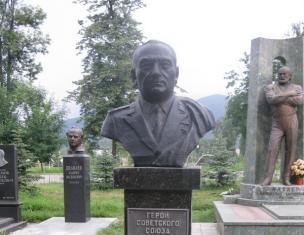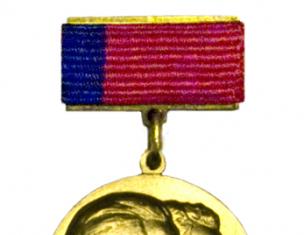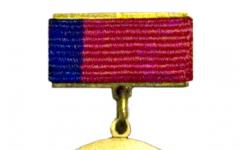This structure was created similarly to the Western European fief-office - an administrative, appointed position in the province. Appointments “to places” took place “from above”, by special order of the tsar or prince. Feeding in Rus' is an analogue of fief-office, in which, instead of money, the state provided other forms of remuneration for service.
Local authorities
In appanage times, the Russian state organized under the leadership of volostels and various governors sent from the capital by special decree. Payment for their labor was carried out locally, although instructions on the amount of remuneration were usually issued in the royal chambers. The feeding system in Ancient Rus' implied that such temporary representatives royal power will be supported by local authorities. Along with monetary allowance, they were given food, horses, servants and funds for their maintenance. Feeding in Ancient Rus' is, first of all, a real opportunity for a person to support himself and his family, using only his official powers and rights granted by princely and later royal power

Formation of viceroyalty
The constant presence of governors in county towns at first it was not required, but sometimes the content was so impressive that gradually the governors indicated their stay at the place of service as permanent. Accordingly, their time in the prince’s service increased, which means their feeding also increased. In Ancient, not only representatives of the local population, but also foreigners found the occupation attractive. Representatives of the younger families of famous European families did not shy away from being governors in Rus' - this occupation made it possible to return to their homeland as a completely wealthy person.

Rus' Moscow
During Muscovy, the system local government still held on to the viceroyalty. As before, governors and volosts ruled locally, administered justice and collected taxes. Feeding in Muscovite Rus' was the name given to the maintenance of such visiting servicemen. The governor's place of service was usually located in the center of the county. Here he held court and administration in all administrative matters within the city and outskirts, and also administered justice in criminal matters within the small counties in which it was so rich Russian state. Within the district borders, the governor's competence included military forces, arsenal and strategic important objects- bridges, dams, etc.

Viceroys
Representatives of famous families were usually chosen as governors, and often passed from father to son. For example, famous family Protasyev reigned in the Meshchersky region for almost two centuries - from the beginning of the 15th to the end of the 16th centuries. This noble family, along with the names of other governors, is known in Russia in a series of prominent statesmen and the king's associates. All these honorary titles would have been impossible without a strong material rear, most of which were rich donations from local authorities. Thus, feeding in Rus' was called a quite decent position with inexhaustible resources that could guarantee a comfortable life for several generations.
Hairers
The volostites held court and administration independently of the governor; they had separate districts under their jurisdiction, but the list of cases under their jurisdiction was different. Usually they dealt with minor offenses, economic disputes, and considered administrative violations. Unlike governors, representatives of the unnamed boyars or impoverished nobles became volosts. At the beginning of their careers, the biographies of volosts are replete with the positions of tiuns, clerks, clerks, and city clerks. That is, their social level was an order of magnitude lower than that of the governors. Nevertheless, feeding in Ancient Rus' not only helped them cope with the problem of living, but also allowed them to get rich at the expense of local authorities.

Typically, working in local government was seen as a position that would allow one to earn a good income. Feeding in Rus' is a source of unjust enrichment for many nobles who were not very eager to fulfill their immediate duties. Instead of themselves, they sent their servants - tiuns and closers - to the places. Feeding was also extended to them. In Rus', this occupation was so attractive that serious bribes were given for the position of tiun. The tiuns had the right to administer justice and deal with cases on behalf of the governor; in fact, they directly carried out his duties and made a good profit from this.
Income from feeding
The list of income from feeding consisted of several parts. Some of the feeding was collected locally with money, but mostly feeding in Rus' is extortion of natural products. Feeding was planned two to three times a year, for large church holidays- Easter, Peter's Day, Christmas. Incoming feeding was also known - they usually greeted the new governor in the district. The collection was carried out by specially appointed people, who were usually selected from the locals. They were assigned the positions of sotskys and elders. Usually, in addition to collecting food, they collected taxes locally, and also forced the local population to perform various duties.

Elimination of feeding
At the beginning of its development, the Russian state consisted of small principalities, the size of which was small, and the judicial and administrative activities of local authorities were completely visible. The ancient laws and customs were still strong, and ordinary people could always complain to the prince about the arbitrariness of his slaves or change their place of residence, moving away from the negligent ruler to another principality. But when the collection of lands around Moscow was almost completed and the centralization of power became strong, ordinary people it wasn't easy. It was then that the proverb arose: “To God is high, but to the king is far.” The vicegerency system practically ceased to fulfill its duties, which its representatives had to perform for feeding. In Rus', this concept quickly became synonymous with bribes and extortion. The scale of corruption has reached such proportions that central government seriously thought about local government reform.
The organization of local self-government became possible thanks to the reform of Ivan the Terrible. One of its main stages was the transfer more powers of voivodeship authorities. Gradually, the volosts and governors disappeared, and with them the feeding system ceased to function.
a method of maintaining officials at the expense of the local population in Rus' until the middle. XVI century Russkaya Pravda contains information about the “feed” for virniks and small towns. In the XIII-XIV centuries. folds up the whole system local government through the Institute of Feeders. The great or appanage prince sent boyars to cities and volosts as governors ("instead" of the prince) and volostels, and others service people- tiuns and various duties. The population was obliged to support them (“feed”) during the entire period of service. The governor, volosts, etc., representatives of the local princely administration usually received obligatory ("prescribed") food three times a year - on Christmas, Easter and Peter's Day. When the feeder took office, the population paid him “entry feed.” Feed was given in kind: bread, meat, cheese, etc.; oats and hay were supplied for the feeding horses. In addition, the feeders collected various fees for their benefit: legal fees, for staining and selling horses, “flat duty”, washing, etc. At the expense of all these fees, they not only fed themselves, but also supported their servants. The feeding system reached its greatest development in the XIV-XV centuries. Since the 15th century The Grand Dukes of Moscow regulate the income of feeders by issuing special “fed” and statutory charters. In the century XV - AD. XVI centuries The government began converting natural feed into cash, while abolishing a number of articles. As a result of the zemstvo reform of 1555-56, the feeding system was eliminated, and the government turned fees for the maintenance of feeders into a special tax in favor of the treasury. N. Nosov
View value Feeding in other dictionaries
Feeding- feeding, plural no, cf. 1. Action according to verb. feed in 1 and 3 digits. There are animals at 6 o'clock. infants. 2. B ancient Rus'- system of remuneration of boyar-administrators by........
Ushakov's Explanatory Dictionary
Feeding- -I; Wed
1. to Feed (1-3 characters). K. horses. Baby feeding time.
2. B Russian state 13th - 16th centuries: system of remuneration for boyars who carried out judicial and administrative........
Kuznetsov's Explanatory Dictionary
Feed, Feeding— - system of maintaining officials - governors, volosts - at the expense of the local population. Eliminated by the zemstvo reform of 1555 - 1556.
Legal dictionary
Feeding— - a method of maintaining officials at the expense of the local population in Rus' until the middle of the 16th century. The prince sent governors and other service people to cities and volosts. Population........
Legal dictionary
Imaginary Feeding- a method for studying the conditioned reflex secretion of gastric juice in an experiment in which the animal, in addition to applying a fistula to the stomach, is first......
Big medical dictionary
Feeding- a system of maintaining officials (governors, volosts, etc.) at the expense of the local population in Rus'. Eliminated by the zemstvo reform of 1555-56.
Big encyclopedic dictionary
Feeding- a method of maintaining officials at the expense of the local population in Rus' until the middle. 16th century Russkaya Pravda contains information about the “feed” for Virniks and Gorodchiks. In the 13th-14th centuries. folds.........
Soviet historical encyclopedia
Force feeding- (gavage) - any measures applied to a patient who does not want or cannot independently take food by mouth (especially force feeding through a tube inserted into the stomach).
Psychological Encyclopedia
Imaginary Feeding- a method for studying the conditioned reflex secretion of gastric juice in an experiment in which the animal, in addition to applying a fistula to the stomach, is first......
Medical encyclopedia
Force feeding (gavage)- any measures applied to a patient who does not want or cannot independently take food by mouth (especially force feeding through a tube inserted into the stomach).
Medical dictionary
in Rus', a system of payment in kind, maintenance at the expense of the local population of certain categories of officials serving in favor of the prince. This system was eliminated under Ivan IV by the zemstvo reform of 1555–1556.
Excellent definition
Incomplete definition ↓
FEEDING
a method of maintaining officials at the expense of the local population in Rus' until the middle. XVI century Russkaya Pravda contains information about the “feed” for virniks and small towns. In the XIII-XIV centuries. A whole system of local government is emerging through the institution of feeders. The great or appanage prince sent boyars to cities and volosts as governors (in place of the prince) and volostels, and other service people as tiuns and various duty officers. The population was obliged to support them (“feed”) during the entire period of service. The governor, volosts, etc., representatives of the local princely administration usually received obligatory ("prescribed") food three times a year - on Christmas, Easter and Peter's Day. When the feeder took office, the population paid him “entry feed.” Feed was given in kind: bread, meat, cheese, etc.; oats and hay were supplied for the feeding horses. In addition, the feeders collected various fees for their benefit: legal fees, for staining and selling horses, “flat duty”, washing, etc. At the expense of all these fees, they not only fed themselves, but also supported their servants. The feeding system reached its greatest development in the XIV-XV centuries. Since the 15th century The Grand Dukes of Moscow regulate the income of feeders by issuing special “fed” and statutory charters. In the century XV - AD. XVI centuries The government began converting natural feed into cash, while abolishing a number of articles. As a result of the zemstvo reform of 1555-56, the feeding system was eliminated, and the government turned fees for the maintenance of feeders into a special tax in favor of the treasury.
the reason for the abolition of feedings in 1556 and received the best answer
Answer from Liza Yashina[newbie]
In the summer of 7064 (1556) the king sentenced and Grand Duke Ivan Vasilyevich of the weight of Russia with his brothers and with his brothers about feeding and serving all people, how you serve them in the future. And to this day, the boyars and princes and boyar children sat for feeding in the city and in the volost, for the dispensation of people and all arrangements for the lands and for themselves from services for peace and food; in which cities and volosts there were governors and volosts in some years, and they did justice and administration to that city and volost and turned all their hardships into good, and they themselves were pleased with their dues and the specified duties that the sovereign laid down for them.
And the pious king heard that many cities and empty volosts had been perpetrated by governors and volosts, having for many years despised the fear of God and the sovereign's regulations, and committed many evil deeds against them; There were no shepherds and teachers for them, but persecutors and destroyers were created for them. Also in those towns and volosts, the peasants committed many treacherous acts and killed their people: and how they go from feeding, and the peasants seek many lawsuits; and there is a lot of bloodshed and desecration of souls in this, but it is not appropriate for them not to be heard in the Christian law; and many governors and volosts and their old acquisitions of excess, bellies and estates.<...>
And the sovereign commanded in the cities and in the volosts to abolish the elders, and hundreds, and five-tenths, and tens, and to lay down a commandment with a terrible and formidable prohibition, so that they would judge between robberies and tats and all sorts of cases, so that no enmity would be waged, nor would unjust recompense , nor false obedience; and whoever found such a dashing character among themselves, he ordered such to be put to death; and for the towns and volosts, place dues according to their trade and lands, and collect those dues for the royal treasuries by your deacon; The boyars and nobles and all the soldiers were given food, lessons for the righteous, he deserves it according to his fatherland and his rank, and for the policemen in the fourth year, and for others in the third year, a cash salary.
(From the “Code of Service” of 1556)
Reply from Nikita Sokolov[newbie]
1
Reply from Can of Raccoons[guru]
There was nothing to feed.
Reply from ЂС[guru]
FEEDING, a system of maintaining officials (governors, volosts) at the expense of the local population in Rus' until the mid-16th century. Initially, feedings were sporadic. In accordance with the norms of Russian Pravda, food collectors, city builders and other categories of service people received in-kind allowances from the population. In the 12th-14th centuries, feeding played a significant role in the formation of the local government system. During this period, feeding was a type of grant from the great and appanage princes to their confidants. The prince sent boyars to cities and volosts as governors and volostels, and other service people as tiuns. The population was obliged to support them (“feed”) during the entire period of service. Representatives of the local princely administration usually received “food” three times a year - on Christmas, Easter and Peter’s Day. When the feeder took office, the population paid him “entry feed”. The feeders received their feed in kind (food), and oats and hay were supplied for the horses. In addition, feeders collected various fees for their benefit: legal fees, for branding (“staining”) and the sale of horses, “flashing”, washing. At the expense of these fees they lived and supported their servants. The feeding system reached its greatest development in the 14th and 15th centuries.
Feeding gave rise to abuses by local officials interested in enriching themselves while in power. Since the 15th century, the Moscow Grand Dukes regulated the income of feeders by issuing special “fed” and statutory charters. At the end of the 15th - beginning of the 16th century, the conversion of natural feed into cash took place. As a result of the zemstvo reform of 1555-1556, the feeding system was eliminated. In 1555, a decree was issued abolishing feedings, which, however, was not applied immediately and not everywhere: sources mention feedings during the second half of the 16th century. Fees for the maintenance of feeders were transformed into a special tax in favor of the treasury (“fed payback”), established in a certain amount for various categories of land (noble, black, palace). Tax collection was carried out on black lands by zemstvo elders, and in areas of local patrimonial land ownership by special collectors or city clerks.
a method of maintaining officials at the expense of the local population in Rus' until the middle of the 16th century. The prince sent governors and other service people to cities and volosts. The population was obliged to support them (“feed”) during the entire period of service. By zemstvo reform 1555-1556 K. was liquidated, and the government turned fees for the maintenance of feeders into a special tax in favor of the treasury.
Excellent definition
Incomplete definition ↓
FEEDING
in Rus' in the 14th-16th centuries. local government system, officials which were supported by fees from the population of the controlled territory. Existed on lands not assigned to the princely palace, privately owned and black. Supreme state power Governors and volosts were appointed for K.; in large principalities there were districts consisting of cities and rural communities (volosts and walls). The apparatus of governors and volostels included tiuns, closers, and pravets. All of them received allowances from the population in kind, and later in money. Viceroyships were usually given to more noble service people, boyars, and volosts - to less noble ones, from free servants. Gradually, the purpose of appanage government was reduced to extracting income from the managed district (hence the term “feeding”). The manager's allowance consisted of feed and taxes. Feed was contributed within certain periods by entire societies, and duties were paid by specific government acts. The feed was one-time (entry) and annual (Rozhdestven, Peter’s, and in some places Velikodensky), they were distributed according to tax units (plows). In a reduced amount, such salary fees were levied in favor of volosts, tiuns and other government officials. Duties were levied on judicial duties (percentage on the amount of the claim or a fine on the perpetrator equal to the amount of the claim), customs duties (on goods sold), wedding duties, etc. Greatest development K. received in Northern Rus' in the 14th-16th centuries. By the end of the 14th century. The central government began to regulate the order of food to limit the arbitrariness of feeders. During the 15th century. a number of so-called charter letters of the viceroyal administration in the name of the population of the area. They established deadlines, sizes of feed and the procedure for filing complaints about abuse by feeders. With the strengthening of the Moscow state, there was a sharp increase in the number of service people, boyars and boyars’ children, which necessitated the need to establish the term of K. (1-3 years), fragmentation of K. (two governors were appointed to half the city). In K., certain items of income began to be awarded: fur, writing, bench, rotary, etc. In the 16th century With the development of monetary relations, they tried to replace natural feed with monetary contributions, which did not eliminate arbitrariness and abuse. Feeders had responsibilities for the income they received; they were reduced mainly to criminal and civil courts for all classes of the population, except those with immunities. An increase in complaints against feeders and the need to restructure local government led in the 16th century. to the partial and then complete abolition of food. Gradually, the collection of feed passed from the hands of the feeders themselves to those elected by society (sotskie, elders), and the most important judicial and administrative matters were removed from the competence of the feeders. In 1539, the first provincial charter was issued, which transferred the right of court to local elected bodies (from nobles and children of boyars), and zemstvo elected officials were introduced into the court of governors and volosts. In 1555, a decree was issued to abolish K. and replace it with heads, elders and kissers. However, feeding in a number of places, according to some sources, existed until the 60s. 18th century Even in 1726, clerks often did not receive salaries, but were content with the practice of pre-Petrine times.








